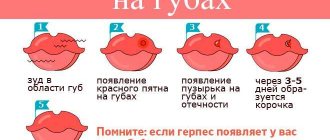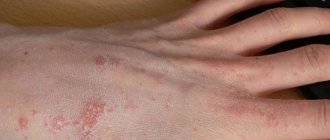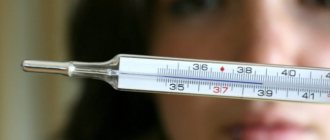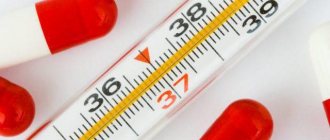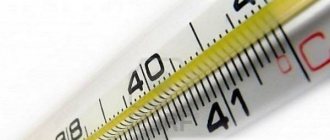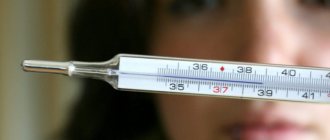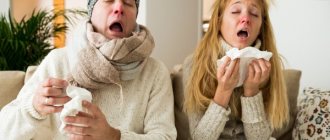The cutting of a baby’s first teeth is a moment that any parents look forward to with anticipation and trepidation. With impatience, because the appearance of teeth is a new milestone in the development of their baby, and with trepidation, because this process is always accompanied by unpleasant symptoms: fever, runny nose, loose stool in the baby or, conversely, lack of stool, cough, excessive salivation, as well as poor sleep. All these and other symptoms of teething in children under one year of age are described in our other article (
Reasons for appearance ↑
During teething, two interrelated processes occur in the child’s body:
- In the tooth growth zone, a large amount of biologically active substances are released, which contribute to the softening and “loosening” of gum tissue - this leads to inflammation of the gums;
- Local immunity in the oral cavity decreases, because of this, the addition of a secondary infection is often observed - stomatitis, sore throat or pharyngitis.
Inflammation and a decrease in local immunity can provoke the appearance of a protective reaction of the body in the form of an increase in body temperature to subfebrile levels (within 37–37.5°C).
Photo: Gum inflammation during teething in children
Increased salivation is also aimed at protecting the oral cavity from microorganisms. Its high content of bactericidal and anti-inflammatory substances provides a kind of disinfection, which is very important in conditions of reduced immunity, inflammation of the gums and the child’s desire to “scratch” them with any available object.
Video: reasons for rising temperature
Why is the temperature rising?
The widespread belief that fever during teething in a child is an absolute norm is erroneous.
The reasons for it are not always associated exclusively with the birth of teeth, and therefore require an attentive attitude. The increase in temperature has the following reasons:
- Teeth growth is a serious physiological stress for the baby.
- The tooth, making its way out, “drills” first the bone tissue, and then the mucous membrane of the oral cavity. A local inflammatory process occurs in the gum area, which is accompanied by fever.
- The greatest likelihood of an increase in temperature occurs during the eruption of canines and molars (chewing teeth). This is due to their deeper location inside the gums and a larger tooth surface that must come out.
- If a child has several teeth erupting at the same time, then fever is more likely than if the teeth come into the world one at a time.
- Teething is an energy-consuming process and immunity decreases during this time. In such a situation, fever is the body’s natural defense reaction against the invasion of infections.
At the same time, fever may indicate that, due to reduced immunity, the child has contracted an infectious disease.
What temperature does a child experience when teething?
The temperature of an infant during teething should not exceed low-grade fever - up to 37.5°C. In this case, it is worth paying increased attention to the child’s condition.
Some children feel fine and do not need antipyretics. Others do not tolerate even a slight increase in body temperature, cannot sleep, cry, are very capricious and refuse to eat.
If the body temperature rises above 38–38.5°C, this is a dangerous sign; such numbers may indicate the onset of an inflammatory process or an infectious disease.
To what maximum numbers can the temperature rise?
An increase in temperature in infants as teeth grow is observed:
- during the period of active eruption of the first teeth - a group of incisors (aged 6 to 10 months);
- when the central molars erupt at one and a half years.
In this case, the baby’s temperature can rise from low-grade to high levels and often reaches 38-39 degrees Celsius.
In addition, the child may experience emotions such as pain and severe weakness for the first time in his life.
Therefore, the baby’s behavior changes, sleep disturbances and refusal to eat are noted, and this only intensifies the temperature reaction.
Parents should know that when the temperature rises above 38.5 degrees Celsius and tends to further increase, it needs to be reduced by taking antipyretic drugs.
These include medications containing ibuprofen (Nurofen, Ibufen) or paracetamol (Efferalgan, Panadol, Cefekon).
They are used only in children's forms (syrup or rectal suppositories) and in a single age dosage, which is indicated in the instructions or prescribed by a specialist
You should not overstimulate the child’s nervous system - play active games with laughter, turn on loud music, bright lights, or TV.
In order to independently cope with the load, the baby’s body needs peace and rest during this period.
Particularly dangerous is the appearance of convulsive reactions against the background of an increase in temperature in the form of a nervous tic, muscle twitching or muscle contraction - the child’s temperature must be brought down immediately at any number (the home medicine cabinet must have Nurofen or another antipyretic drug) and an ambulance must be called.
Danger of high temperature ↑
High temperatures above 39–40°C are dangerous for children in their first year of life, especially if they have neurological disorders. It can cause seizures, breathing problems and palpitations.
The younger the child’s age, the more reasons for concern his parents have - this is due to the relative immaturity of the child’s brain and the entire body as a whole.
Of particular danger is a rapid increase in body temperature over several hours and a high temperature that persists for a long time, despite the therapy.
With a rapid increase in temperature, the temperature center in the brain may not be able to withstand the load, and there is a risk of seizures. The risk of their occurrence is directly proportional to the age of the child - the younger the child, the higher the risk of occurrence. After three to five years, seizures practically do not occur.
The seizures last about 10 to 20 seconds and usually do not cause much harm to the baby. It is important to control his breathing and heartbeat.
Children with neurological disorders are a special risk group. If the baby is undergoing treatment or observation by a neurologist, you should start giving antipyretics at 37.5 degrees.
A prolonged increase in body temperature above 38–38.5°C is also a reason to consult a doctor. This condition depletes the child’s body and can cause dehydration and disorders of the cardiovascular and other body systems.
Increased temperature on teeth
Fever in a child during teething without additional symptoms of the disease is a common phenomenon. It is fixed when the baby reaches the age of 6 months. At this time, most children's first tooth comes out. Fever may be accompanied by symptoms such as:
- refusal to eat;
- drowsiness;
- whims;
- nervousness;
- anxiety.
The baby constantly asks to be held, has trouble falling asleep and cries a lot. Behavior changes occur due to the presence of pain and discomfort. Fever can also lead to diarrhea or vomiting.
During the eruption of the first and subsequent teeth, biologically active substances enter the child’s body. They cause softening of the gum tissue. As a result, an inflammatory process and an increase in body temperature are observed.
Attention! Fever negatively affects the immune system. During this period, the risk of secondary infection, stomatitis or sore throat increases. As a result, the temperature increases to 37.5-38, rarely to 39 degrees.
Anxiety and tearfulness are natural manifestations of discomfort.
Among the accompanying manifestations of teething is active salivation. This is a protective reaction on the part of the body to the appearance of foreign microflora. Saliva contains substances that prevent inflammation. They carry out active disinfection in the oral cavity. The baby tries to relieve pain by gnawing on objects or toys. It is recommended to wipe the surfaces with which the baby comes into contact to reduce the number of microorganisms in the mouth.
As soon as a tooth is about to erupt, the child’s body reacts instantly. The normal figure for this period of time is 37-37.5 degrees. The general health of the baby may be normal. In some cases, he does not lose his appetite and plays actively. There is no need to specifically lower the temperature.
We suggest you read: Can pregnant women drink badger fat?
The appearance of the first teeth in only 10% of babies under 1 year occurs without the manifestation of corresponding symptoms. When a child is teething, the temperature rises actively. The baby begins to put things in his mouth, bite toys, objects, clothes and his own fingers. He can catch a cold very easily because his immune system is weakened. At night, sleep duration is disrupted. A strong reaction occurs to growing front teeth or canines.
The reasons for the increase in temperature indicators are associated with several processes that occur in the body:
- An increased amount of active components is released at the site of eruption. They lead to softening of the gum tissue, sometimes affecting the jaw bones. The advancement of the tooth is facilitated, but the body reacts by increasing the temperature;
- The immune system weakens, protection decreases. The infection occurs faster at this moment.
A symptom such as vomiting appears. It is associated with an increased amount of saliva, which is produced to eliminate microorganisms from the oral cavity. A large amount of it leads to gastrointestinal disorders. By the presence of such manifestations, parents will be able to understand that the period of teething has begun.
The child has a desire to put everything in his mouth
Attention! In addition to the main symptoms, symptoms of a cold may appear: snot, slight coughing. In this case, it is recommended to consult a doctor to begin proper treatment.
Fever in an infant ↑
If an infant becomes restless, often cries, refuses to eat, asks to be held, and is difficult to distract with toys or anything else, then this behavior indicates normal teething.
The situation is much more difficult when the baby lies all the time, does not react to anything, behaves quietly or sleeps most of the day. This behavior is a sign of a child’s serious condition; it is necessary to check the body temperature every hour and try to reduce it by a few degrees.
Body temperature in infants should be checked in the armpit or inguinal fold. It is best to do this when the baby is calm, sleeping or eating; the skin should be dry and warm when measured.
If it is impossible to hold the thermometer for the prescribed time, you can take a rectal measurement. To do this, you need to lubricate the tip of the thermometer with baby oil or cream and carefully, using rotational movements, insert it into the rectum about 1 cm. Then squeeze the buttocks tightly and hold for 5 minutes.
Normal temperature in the rectum is 37.0–37.5°C, elevated temperature is above 38.5°C.
Also, the severity of the condition in an infant can be determined visually - the face becomes red, the cheeks “burn”, the lips dry out, the eyes become moist and shiny, the skin feels dry and hot to the touch. The child cries often and rarely urinates.
When should you call a doctor?
If the child’s condition is complicated not only by elevated temperature, but also by other alarming symptoms, you need to call a doctor. To detect this, you must not leave the baby for a minute and watch him very closely. What signs are a signal:
- Very high temperature of 40 degrees and above. No antipyretics either work or only work for a short time. Then it is not the local doctor who is called, but an ambulance.
- Cramps. Signs of convulsive readiness are involuntary trembling or tension of the whole body. Mild convulsions during sleep can go away on their own, but if the child is shaking violently, his eyes are rolling, his body is arching and turning blue, then it is also necessary to urgently call an ambulance.
- Other signs: vomiting, diarrhea, skin rash. It is necessary to consult a local doctor, as these symptoms may indicate both an imbalance of digestion and complications with other diseases.
- Duration of the process. If the temperature does not subside for 3 days or more, you also need to be examined by a specialist.
Parents need to monitor the baby's condition. If symptoms arise suddenly and develop rapidly, or if they last for a long time, professional help is indispensable.
If your child begins to have seizures or symptoms of an upset stomach, they should be seen by a doctor immediately
Eruption of permanent teeth ↑
Most parents believe that molars are those that grow to replace baby teeth. In fact, all teeth are molars.
Experts divide teeth into milk and permanent teeth. It is the permanent teeth that are popularly called “molars.”
Body temperature rarely rises during the eruption of permanent teeth, since the body of an older child tolerates all changes quite easily. Premolars and molars usually have difficulty erupting. These are large teeth, and their eruption can be accompanied by infection, fever and general malaise.
In children after a year, it is not difficult to determine why the temperature has risen; they may show a sore spot or complain of pain in the gums.
When to sound the alarm
- A prolonged increase in body temperature during teething at 39 degrees (when measured with a mercury thermometer in the armpit) is really dangerous for children under one year old. This temperature needs to be brought down. But you shouldn’t do this in every possible way so as not to harm the child’s body.
- A bad symptom is a sharp increase in body temperature to high levels against the background of the onset of diarrhea, rash, and cough. In such situations, you should seek emergency medical attention.
- It is a warning sign if the fever does not subside when using paracetamol for children, provided that the correct dosage of the drug is followed. It is worth seeking emergency medical help.
- Urgent measures should be taken if the child has diseases of the nervous system.
In any situation when it comes to an increase in body temperature in babies of the first year of life, you should contact your local doctor or pediatrician. Self-medication in children can lead to very bad consequences.
How to help your baby
Children tolerate high fever differently. Some people feel very bad at 37.5, and some kids are cheerful at 38.5. But be that as it may, fever in children during teething does not have an important protective function for the body, so it can be brought down as soon as the mercury on the thermometer reaches 38.
Ways to reduce ↑
Before you start lowering your body temperature, you need to make sure that it is caused by teething and not a cold or viral disease.
Create a comfortable environment for the child - ventilate the room, humidify the air using special devices or simply hang a wet sheet, give the baby warm water, remove excess clothing, especially a diaper.
Photo: Humidifier
If after all these measures the temperature has not changed, you can begin to reduce it using physical or medicinal methods.
Does it hurt to swallow? Find out about effective remedies for sore throat when swallowing. When do baby teeth change to permanent ones? Read here.
Video: elevated temperature in a child
Medication method
In order to bring down the temperature, use modern medications that are suitable for the child’s age:
- Paracetamol . To reduce the temperature in children from birth, you can use drugs based on paracetamol (asetomifene) - Panadol, Efferalgan, Teylenol, Calpol, Cefekon D. Today, these drugs are considered the safest for children in the first years of life. If a child has a body temperature above 38.5°C, you should give him 1 dose of the drug or put a suppository with paracetamol. Within 20–30 minutes, a decrease in temperature by 1–2 degrees and relief of the patient’s condition are observed.
- Ibuprofen . If paracetamol-based drugs are ineffective, you can use ibuprofen-based drugs - Ibuprofen or Nurofen for children. But these products are not recommended for children under 1 year of age.
- Nimesulide . Preparations based on nimesulide have a pronounced antipyretic effect, but are more toxic; they should be used only as prescribed by a doctor and for no more than three days in a row - Nice, Nemulide, Nimesil.
- Seduxen . In addition to antipyretics, at high temperatures, a child can be given Seduxen - 1/4 tablets; this mild sedative is prescribed in cases of excessive excitement, moodiness and inability to sleep.
Photo: Preparations with paracetamol - Cefekon D (left) and Panadol (right)
Photo: Children's Nurofen (left) and Nimesil (right)
Aspirin and analgin are not used in children's practice - these drugs have too many side effects and are toxic to the child's body.
All antipyretic drugs should be taken in consultation with your doctor, keeping an interval between doses of at least 4-6 hours and no longer than 3 days in a row.
Physical method
Photo: Rubdown
Low temperatures are brought down using physical cooling methods:
- Rubdowns . The simplest method is to undress the child and wipe him with water at room temperature. If the child is an infant, it is enough to undress him, remove the diaper and cover him with a light diaper. If the temperature does not drop, you can wipe it with clean warm water, without vinegar or alcohol. You need to wipe your hands, feet, armpits and groins, knees and elbows. Such procedures can be repeated every 2–3 hours. Make sure that the child does not become hypothermic as a result of rubbing.
- Warm shower . Recommended for older children. Helps reduce temperature and relieve tension.
- Drink plenty of fluids. You need to give your child more cool, sour liquid - this will help quench thirst, avoid dehydration and lower body temperature.
You should not try to quickly reduce the temperature to normal levels - it is enough if it drops by 1-2 °C.
Other measures
Dr. Komarovsky, known as a proponent of natural baby care, talks about physical cooling methods. Often parents make do with just rubbing and drinking plenty of fluids, without giving pills at all.
How to do rubdowns? The baby needs to be undressed, and if the house is cool, you will have to heat the air in the room until warm so that the baby does not get cold. For wiping, a soft cloth is moistened in clean warm water. No alcohol or vinegar! When wiping, special attention is paid to the hands, feet, armpits and groins, knees and elbows. To cool an infant, simply remove his diaper and clothes, then cover him with a thin diaper.
How does drinking plenty of fluids help? When teeth are cut and the temperature rises, the body loses a lot of fluid. If you give your child warm water to drink as often as possible, the fluid in the body will be replenished, water quenches thirst and prevents dehydration. In addition, it removes toxins from the body and reduces temperature.
If the temperature has not yet completely returned to normal, but has dropped by 1-2 degrees, that’s already good. The main thing is to start this process and gradually everything will return to normal.
The baby needs plenty of fluids - it helps restore the balance of fluid in the body and ensure a speedy recovery with the help of its own immunity.
When should you lower your temperature? ↑
It is necessary to focus not only on the readings of the thermometer, but also on the condition of the child. If a child feels unwell, constantly cries, is very capricious, and cannot sleep, it is worth giving him an antipyretic, even if the temperature is less than 38 °C.
It is necessary to reduce the temperature during teething in children under 6 months of age if they have neurological diseases or are registered with a neurologist.
Video: what temperature should be reduced
Teething, fever: what to do?
Whatever the reason for the increase in body temperature in a child, it is always stressful for loving parents, because it is not easy not to be able to alleviate the baby’s condition and just observe. There are two encouraging points here.
Firstly, in most cases, children tolerate fever easily: it rises more easily in them than in adults, and goes down quite easily. Secondly, parents can do a lot.
The obvious solution is to shoot it down, but you shouldn’t do this until 38 degrees.
And after this limit it is not always necessary to knock down - you need to focus not on the readings of the thermometer, but on the condition of the baby.
If the general condition is not disturbed, it is impossible to reduce the temperature. There are often situations when a baby plays calmly at a temperature of 39.
If the child is restless and clearly does not feel well, then the temperature should be brought down. The usual children's remedies are excellent for this - Panadol, Paracetamol.
When making a decision, parents should be aware of the dangers of high fever. In some cases, it puts increased stress on the heart, liver, lungs and even the brain.
But you shouldn’t be afraid of any temperature - in addition to the condition of the baby himself, the nature of the temperature matters.
The danger is that it persists for a long time or rises extremely, despite antipyretic drugs.
In the pharmacy you can find a large number of special gels and ointments that make teething easier.
You should know the following about them:
- any such product can cause an allergic reaction, so it should be used with caution;
- no drug is a panacea - it may help some children, but most likely will not feel much of a difference “before and after”.
The fairly effective pain-relieving gel Cholisal has a specific taste, smell, and can even cause a burning sensation at the site of application.
READ Can teeth erupt at 3 months?
Therefore, you should be prepared for the fact that the child will become even more anxious from such help.
However, if the baby reacts normally to the taste of the medicine, then the effect should be quite good.
Otherwise, pediatricians do not recommend forcing the baby, and given the cheap cost of the drug, in many cases it is worth initially trying to do without it.
Calling a doctor ↑
You should call a doctor if your child develops symptoms that worsen their condition.
Alarming symptoms:
- Heat . Body temperature above 40°C and taking an antipyretic reduces it only for a short time,
- Cramps . Convulsive readiness or convulsions - with high body temperature in young children, you may notice involuntary trembling of the limbs or unnatural tension of the body. These are signs of convulsive readiness. In this case, and if the child has convulsions, he is shaking, his eyes are rolling, he turns blue, he arches, you need to immediately contact an ambulance.
- Additional symptoms . The child has a high fever, vomiting, diarrhea, or a rash.
- Duration . Body temperature lasts for three days or more
When to see a doctor if your baby has a high fever
You can and should call a pediatrician at home or go to a clinic if:
- A high temperature is difficult to bring down with antipyretic drugs or is only brought down only for a short period of time.
- The baby's body temperature reaches 39C and above.
- The baby behaves very lethargically and inhibited, eats little, sleeps poorly, and cries often. If he has an ashy skin color, cold feet and the child moans.
- In addition to elevated body temperature, a number of other symptoms that are unpleasant for mother and baby are observed - cough, runny nose, vomiting, diarrhea.
Frequently asked questions ↑
What to do if a child has a temperature of 39 and diarrhea when teeth are being cut?
Diarrhea during teething occurs due to the large amount of saliva that the child swallows over time. In this case, the stool is watery, “clean”, without impurities or unpleasant odor.
For treatment, it is enough to give an antipyretic, more fluids and monitor the child’s condition.
What to do if antipyretic drugs do not help?
You should try physical cooling methods, give a double dose of an antipyretic, wait for an hour and, if the temperature does not decrease, call an ambulance.
Usually in these cases, doctors give an injection of an antipyretic with a vasodilator intramuscularly.
Worried about your tooth? Learn about the symptoms of pulpitis. Current prices for transparent braces are here.
Does your baby have his first teeth at 3 months? Read about early teething in this article.
How to help your child when teething?
- Like any person during illness, the baby needs care, affection and attention. Mom and dad should be patient with his sometimes incessant whims, hug him more often and in no case take out anger and fatigue on the child. If the baby is fed breast milk, then additional (not during regular feeding) sucking on the mother’s breast can help him. calm down and soothe the pain in your mouth.
- If the baby tolerates the teething period well, behaves actively and does not have a high fever, then you can take him for a walk outside.
- Healthy sleep at a comfortable room temperature will ensure your baby is in a good mood after waking up.
- Pediatricians do not recommend bathing a baby who is teething. Still, he has a fever. It is better to wipe the baby with wet wipes or tampons during teething; you can also wash your face with water in the morning. It is imperative to wash the child when he goes “big”.
In order for the baby’s teething period to pass without incident and consequences for him and the parents, it is necessary to very closely monitor the child’s condition. Let us remind you that increased body temperature during teething, although a common occurrence for babies, can also be a signal that the child has pain in something else besides his teeth . It is important not to miss this signal and start fighting in time against such common diseases that accompany teething, such as bronchitis, sore throat, inflammation of the oral cavity and other complications.
How long can a fever last?
How many days can a temperature reaction on teeth last? Pediatricians have differing opinions on this issue.
Some say 1-2 days, others allow up to 3 days. In any case, as soon as the crown appears above the gum, the thermometer should show numbers no higher than 36.6 degrees. The temperature on the teeth increases from time to time during the day or at night. It is easily knocked down with the help of antipyretics.
With viral infections, the fever will last for about three days, a runny nose, hyperemia of the pharynx will appear, and a possible sore throat and cough.
